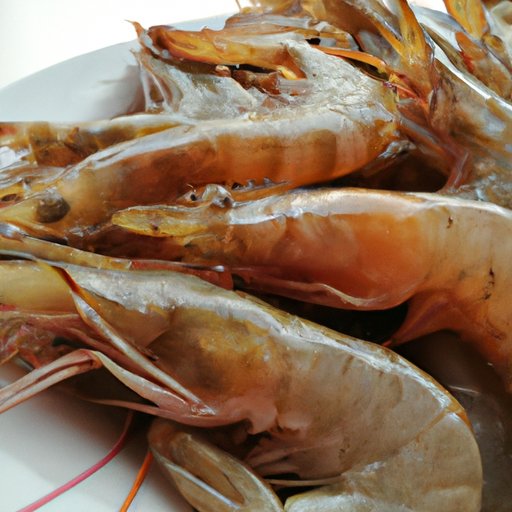Introduction
Shrimp is a popular seafood choice among many people, but is it actually healthy to eat? In this article, we’ll explore the nutritional benefits and potential health risks of eating shrimp, as well as provide tips for selecting, preparing, and enjoying healthy shrimp dishes.
Exploring the Nutritional Benefits of Eating Shrimp
Shrimp is an excellent source of several essential nutrients. It’s particularly high in protein, containing 12-20 grams per 3-ounce serving. It also contains low amounts of fat and carbohydrates, with only 1 gram of fat and 0-1 grams of carbohydrates per 3-ounce serving.
In addition to macronutrients, shrimp is also a good source of several vitamins and minerals. It’s particularly rich in vitamin B12, providing approximately 25% of the recommended daily value (DV) per 3-ounce serving. It’s also a good source of selenium, phosphorus, and zinc, providing 10-20% of the DV of each mineral per 3-ounce serving.
Shrimp also provides some other beneficial nutrients, such as omega-3 fatty acids and astaxanthin. Omega-3 fatty acids are important for heart health, while astaxanthin is a powerful antioxidant that may help reduce inflammation and protect against sun damage.
Examining the Health Risks of Eating Shrimp
Although shrimp can be a healthy choice, there are some potential health risks associated with its consumption. The most significant risk is contamination from pollutants and toxins such as mercury, lead, and arsenic. These contaminants can accumulate in shrimp and may have adverse effects on human health if consumed in large quantities.
Shrimp can also cause allergic reactions in some people. If you have a known allergy to shellfish, it’s important to avoid eating shrimp. Additionally, some people may experience digestive issues after eating shrimp, such as nausea, vomiting, or abdominal pain.
Finally, it’s important to be mindful of portion sizes when eating shrimp. Consuming too much can lead to weight gain and an increased risk of certain diseases, such as heart disease and diabetes.

A Guide to Choosing Healthy Shrimp Dishes
When selecting shrimp dishes, there are several factors to consider. First, opt for wild-caught shrimp whenever possible. Wild-caught shrimp are less likely to be contaminated with pollutants and toxins than farmed shrimp. Additionally, wild-caught shrimp tend to be higher in essential nutrients than farmed shrimp.
If you’re buying pre-cooked shrimp, look for labels that indicate the shrimp has been cooked properly. Avoid shrimp that have been frozen or stored in brine, as these can be high in sodium. Also look for products that don’t contain any added ingredients, such as preservatives, artificial colors, or flavorings.

The Pros and Cons of Eating Shrimp
Eating shrimp can be a healthy choice, but it’s important to weigh the pros and cons before adding it to your diet. On the plus side, shrimp is a good source of protein, vitamins, and minerals, and it contains beneficial omega-3 fatty acids and astaxanthin. On the downside, it can be contaminated with pollutants and toxins, and there is a risk of allergic reactions and digestive issues.

Tips for Preparing and Enjoying Healthy Shrimp Meals
To ensure that your shrimp dishes are as healthy as possible, follow these tips for cooking and enjoying them. When cooking shrimp, make sure to cook them thoroughly to reduce the risk of foodborne illness. Additionally, avoid breading or frying shrimp, as this adds unnecessary calories and fat.
There are plenty of easy and delicious ways to enjoy shrimp. Try adding shrimp to salads, stir-fries, pasta dishes, tacos, or soups. You can also skewer shrimp and grill them, or make a shrimp scampi with garlic, butter, and white wine. For a healthy snack, try making homemade shrimp chips with olive oil, garlic powder, and cayenne pepper.
Conclusion
In conclusion, shrimp can be a healthy choice when prepared and enjoyed properly. It’s an excellent source of protein, vitamins, and minerals, and it contains beneficial omega-3 fatty acids and astaxanthin. However, it’s important to be aware of the potential health risks associated with eating shrimp, such as contamination from pollutants and toxins, as well as the risk of allergic reactions and digestive issues. When selecting and preparing shrimp dishes, opt for wild-caught shrimp and avoid added ingredients. With these tips in mind, you can enjoy shrimp as part of a nutritious and balanced diet.
(Note: Is this article not meeting your expectations? Do you have knowledge or insights to share? Unlock new opportunities and expand your reach by joining our authors team. Click Registration to join us and share your expertise with our readers.)
